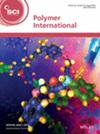求助PDF
{"title":"Characterization of fluorescent poly(diallyldimethylammonium ion)–sulfonated rhodamine dye complexes and their interactions with chloride and carboxylate ions","authors":"Anna M Johnson, Frederick Jutton, Edward E Remsen","doi":"10.1002/pi.70002","DOIUrl":null,"url":null,"abstract":"<p>Aqueous mixtures of the poly(diallyldimethylammonium cation) (<i>p</i>DADMA<sup>+</sup>) and the fluorescent anionic dye Alexa Fluor® 546 (A546) are characterized using multiple fluorescence spectroscopy techniques. A546 and <i>p</i>DADMA<sup>+</sup> demonstrate binding interactions leading to the formation of noncovalent A546–<i>p</i>DADMA<sup>+</sup> complexes based on the quenching and recovery of A546 fluorescence emission intensity as a function of <i>p</i>DADMA<sup>+</sup> concentration. Fluorescence anisotropies of the mixtures support the results of fluorescence emission intensity analysis and yield a sub-micromolar equilibrium dissociation constant for the complexes indicating that strong attractive electrostatic interactions produce complexation. Fluorescence correlation spectroscopy (FCS) characterization of the complexes in solutions containing systematically varied concentrations of either chloride or carboxylate anions suggests chain dimension collapse of <i>p</i>DADMA<sup>+</sup> in the complexes and preferential binding of A546 anions to lower-molecular-weight complexes in solution. Comparison of these effects as a function of solution ionic strength produced by chloride, monocarboxylate and dicarboxylate anion addition indicates that carboxylate anions have significantly stronger binding interactions with <i>p</i>DADMA<sup>+</sup> than chloride ions. Differences in the binding of aliphatic carboxylate anions of different chain length with <i>p</i>DADMA<sup>+</sup> are attributed to differences in their hydrophobic interactions with the organic polymer chains of <i>p</i>DADMA<sup>+</sup>. Further FCS studies of noncovalent A546–<i>p</i>DADMA<sup>+</sup> complexes prepared from narrow-molecular-weight fractions of <i>p</i>DADMA<sup>+</sup> hold the promise of deeper insights into the binding behaviors and hydrodynamic size variability of this industrially important polyelectrolyte. © 2025 Society of Chemical Industry.</p>","PeriodicalId":20404,"journal":{"name":"Polymer International","volume":"74 11","pages":"981-989"},"PeriodicalIF":3.6000,"publicationDate":"2025-06-26","publicationTypes":"Journal Article","fieldsOfStudy":null,"isOpenAccess":false,"openAccessPdf":"","citationCount":"0","resultStr":null,"platform":"Semanticscholar","paperid":null,"PeriodicalName":"Polymer International","FirstCategoryId":"92","ListUrlMain":"https://scijournals.onlinelibrary.wiley.com/doi/10.1002/pi.70002","RegionNum":4,"RegionCategory":"化学","ArticlePicture":[],"TitleCN":null,"AbstractTextCN":null,"PMCID":null,"EPubDate":"","PubModel":"","JCR":"Q2","JCRName":"POLYMER SCIENCE","Score":null,"Total":0}
引用次数: 0
引用
批量引用
Abstract
Aqueous mixtures of the poly(diallyldimethylammonium cation) (p DADMA+ ) and the fluorescent anionic dye Alexa Fluor® 546 (A546) are characterized using multiple fluorescence spectroscopy techniques. A546 and p DADMA+ demonstrate binding interactions leading to the formation of noncovalent A546–p DADMA+ complexes based on the quenching and recovery of A546 fluorescence emission intensity as a function of p DADMA+ concentration. Fluorescence anisotropies of the mixtures support the results of fluorescence emission intensity analysis and yield a sub-micromolar equilibrium dissociation constant for the complexes indicating that strong attractive electrostatic interactions produce complexation. Fluorescence correlation spectroscopy (FCS) characterization of the complexes in solutions containing systematically varied concentrations of either chloride or carboxylate anions suggests chain dimension collapse of p DADMA+ in the complexes and preferential binding of A546 anions to lower-molecular-weight complexes in solution. Comparison of these effects as a function of solution ionic strength produced by chloride, monocarboxylate and dicarboxylate anion addition indicates that carboxylate anions have significantly stronger binding interactions with p DADMA+ than chloride ions. Differences in the binding of aliphatic carboxylate anions of different chain length with p DADMA+ are attributed to differences in their hydrophobic interactions with the organic polymer chains of p DADMA+ . Further FCS studies of noncovalent A546–p DADMA+ complexes prepared from narrow-molecular-weight fractions of p DADMA+ hold the promise of deeper insights into the binding behaviors and hydrodynamic size variability of this industrially important polyelectrolyte. © 2025 Society of Chemical Industry.
荧光聚二烯基二甲基铵离子磺化罗丹明染料配合物的表征及其与氯离子和羧酸离子的相互作用
聚(二烯基二甲基铵阳离子)(pDADMA+)和荧光阴离子染料Alexa Fluor®546 (A546)的水混合物使用多种荧光光谱技术进行表征。基于A546荧光发射强度随pDADMA+浓度的猝灭和恢复,A546和pDADMA+表现出结合相互作用,形成非共价A546 - pDADMA+复合物。混合物的荧光各向异性支持荧光发射强度分析的结果,并产生亚微摩尔平衡解离常数,表明强吸引静电相互作用产生络合。荧光相关光谱(FCS)表征了在系统地含有不同浓度氯离子或羧酸阴离子的溶液中的配合物,表明配合物中的pDADMA+链尺寸坍塌,并且A546阴离子优先结合溶液中较低分子量的配合物。比较氯离子、单羧酸盐和二羧酸盐阴离子的加入对溶液离子强度的影响,发现羧酸盐阴离子与pDADMA+的结合作用明显强于氯离子。不同链长的脂肪族羧酸阴离子与pDADMA+结合的差异归因于它们与pDADMA+有机聚合物链的疏水相互作用的差异。进一步的FCS研究由pDADMA+的窄分子量组分制备的非共价A546-pDADMA +复合物有望更深入地了解这种工业上重要的聚电解质的结合行为和水动力尺寸变化。©2025化学工业协会。
本文章由计算机程序翻译,如有差异,请以英文原文为准。


 求助内容:
求助内容: 应助结果提醒方式:
应助结果提醒方式:


